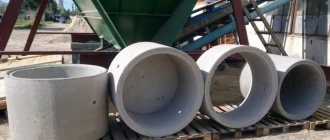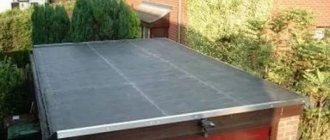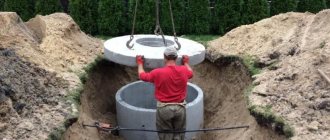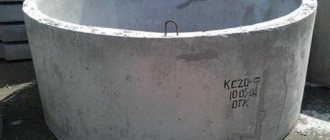Residents of the private sector, deprived of access to a centralized sewer line, have to solve the problem of organic waste disposal on their own by constructing various types of treatment or storage facilities for autonomous sewerage on their site. There is a wide range of ready-made septic tanks of various designs on sale, but many homeowners build treatment wells with their own hands by purchasing sewer rings from the retail chain.
It should be noted that large-diameter ring reinforced concrete products (RCP) are often used in households and for other purposes, using them to assemble engineering structures of various types and purposes. Many homeowners, in addition to certain knowledge about the varieties, auxiliary elements, standard sizes and costs, will benefit from information on how to dig sewer rings from various materials.
Rice. 1 Concrete sewerage for drainage - device diagram
Types of sewer rings and their scope of application
To drain sewer water, pipes are usually used that are made of polymer materials, cast iron, ceramics, asbestos cement, reinforced concrete; these products generally have a small diameter, with the exception of structures made of lightweight plastic components. If a large pipeline diameter is required for laying underground communications, the weight of long pipes becomes too large for transportation and installation of the line, so it is constructed from short rings.
Due to their low cost, wide sewer rings are made only from concrete, and this material currently has no competitors. With the development of modern technologies and the tendency to use polymers in all areas, analogues of concrete products have appeared on the market relatively recently - polymer-sand rings, which are used only for the construction of vertically installed structures.
If in the urban planning field, underground horizontal communications are laid from reinforced concrete rings for transporting organic waste, storm and gray wastewater, they are used as protection for water supply and gas pipelines, then in the household sector their use is of a different nature. In individual areas, reinforced concrete sewer rings serve as the main elements in the construction of the following structures:
Water intake wells. Installation of wells for collecting drinking water from reinforced concrete rings is one of the most popular methods of supplying water to individual residential buildings in urban and rural areas. The mine is dug manually or mechanized, after which sewer wall rings with a lock are immersed in it. If a well is made of concrete rings on the site, the depth of the structure can reach 30 m - in this case, a submersible electric pump is used to draw water.
Septic tanks. Some homeowners use sewer rings to build septic tanks or sedimentation tanks with their own hands, using structures with a closed bottom and top.
Drainage wells. Installation of reinforced concrete rings for sewerage in households is one of the most common areas of their application. Sewage water treated in individual septic tanks is disposed of on its own site, using aeration fields or drainage wells for additional purification and direction of wastewater underground. Many people install the drainage chamber with their own hands from reinforced concrete rings, installing several elements with a locking connection on top of each other in a vertical position.
Rice. 2 Engineering structures made of reinforced concrete rings
Inspection wells. Engineering structures of this type are needed for sewerage in a private house in cases where the underground pipeline has a large length or branches. To carry out cleaning, preventive work and inspection, small diameter wells are placed along the sewer pipeline. They are designed to provide access to inspection hatches installed in pipes for cleaning them in case of blockages and monitoring the condition of the line.
Caisson wells. A well made of reinforced concrete rings is often used to place pumping equipment in it, to protect a well source of water from freezing and precipitation when it is collected by a submersible electric pump or a surface pumping station. The depth of such structures usually does not exceed 2 m; during installation, they often use rings with a finished bottom or upper ceiling with a hole for a hatch; another installation option is to install separate round slabs for the bottom and upper manhole. Also, for caisson wells, experienced users purchase ready-made structures with built-in metal running brackets located along the entire height of the wall.
Septic tanks. Often in private households, especially in rural areas, residents who are deprived of access to a centralized sewerage system share waste disposal. They install a separate toilet for feces on the street, and gray water after washing dishes, laundry, cleaning rooms and other household needs is poured through sewer pipes into a drainage sump constructed from concrete rings.
Cellars. Concrete rings with a bottom can be used on a private plot for the construction of cellars intended for storing fruit and vegetable products deep underground in winter and summer.
Horizontal passages. When laying utilities under roads, to transfer water masses to the other side of highways and railways, large-diameter reinforced concrete rings are often used, which are simpler and easier to lay sequentially one after another than to immediately stretch a heavy long pipe.
Rice. 3 Excavation of soil for wells using special equipment
Calculation of tank volume
One of the key conditions for the uninterrupted operation of a treatment plant is the correct calculation of its volume.
To correctly calculate the volume of a septic tank, you need to focus on three parameters:
- The number of people who live in the house permanently.
- Total daily volume of sewage waste per person.
- The period of time during which organic substances have time to be completely processed.
When calculating, it is taken as a basis that the average daily volume of wastewater per household is 200 liters. On average, it takes up to three days to process organic substances inside a treatment plant.
When making calculations, it is also worth taking an additional margin of 15-20%. It will allow you to avoid overfilling the norm in case of a temporary increase in the number of household members and guests staying in the house for several days.
So for a family of four people, a structure with a capacity of 200 liters x 3 days will be required. x 4 people = 2.4 cu. m. We round the value and find that for a family of 4 people you need a septic tank with a capacity of 2.5-3 liters.
Concrete rings for sewerage
When manufacturing concrete sewer rings, they are guided by sections of GOST 8020-90, which regulate the technical conditions for this type of product. Its main provisions include the following points useful for specialists and ordinary consumers:
- The structures are made from heavy concrete in accordance with GOST-26633 with a compressive strength of 70% of its grade or class.
- For reinforcement, rod reinforcing wire, thermomechanically hardened or hot-rolled steel are used.
- Well rings must comply with the requirements of GOST 13015-2012, which regulate their parameters according to the following indicators:
- rigidity, strength and crack resistance of structures without load;
- physical strength of concrete in its original finished form, and tempering strength after manufacturing the product;
- waterproof and frost-resistant;
- thickness of the concrete layer to the built-in reinforcement;
- grades of steel for fittings, running and loop fillings.
If the design documentation stipulates the placement of running brackets inside the rings, they are installed along the entire height at a distance of 300 mm from each other with a protrusion of 120 mm.
Rice. 4 Concrete rings for sewerage - dimensions according to GOST 8020-90
Related article:
Sewerage in the country - options, design diagrams and installation. If you need to install a sewer system in your dacha, then in a separate article read about all the possible expensive and cheap options for arranging a sewer system in your dacha. Nuances, types, schemes.
Concrete rings and auxiliary structures have symbols consisting of the following sequence of alphabetic and numeric symbols with the explanation below:
What is required to calculate the volume of a septic tank?
Naturally, the key importance when designing an installation is its dimensions, or rather the working (active) volume of the septic tank, which is calculated:
Let's look at how to calculate the volume of a septic tank for a home using simple tabular and formula calculations.
Types and characteristics of concrete rings
Reinforced concrete rings in accordance with GOST 8020-90 are made of concrete grades M200 or M500, using reinforcement with a diameter of up to 10 mm, made of steel class At-IIIC, At-IVC (GOST 10884) and A-I, A-II, A-III ( GOST 5781), as well as BP-I wire (GOST 6727), with a cross-section of at least 0.6 mm. In everyday life, when constructing sewer wells, the following types of rings and auxiliary elements are used:
KS - wall rings in accordance with GOST 8020-90 have an internal diameter from 700 to 2500 mm, a height from 290 to 1190 mm, the thickness of their walls is in the range from 70 to 100 mm. Products are produced both with smooth ends and with protrusions for installation with a locking connection. It is allowed to increase the dimensions of concrete rings for sewerage in height in increments of 300 mm up to a value of 1790 mm.
It should be noted that reinforced concrete products are produced not only by factories, but also by numerous commercial firms - this contributes to a departure from the requirements of the outdated GOST of the 90s. On the market you can find many products that have a greater height and smaller wall thickness (50 mm instead of the minimum 70 mm according to the old standard).
Rice. 6 Parameters of PP floor slabs
KO - support rings installed on top of the structure to create a low neck, which is then covered with a hatch. Concrete rings for KO sewerage specified in the standard have a single standard size with an internal diameter of 580 mm, a wall thickness of 130 mm and a height of 70 mm.
In contrast to the requirements of GOST 8020-90, commercial companies supply the market with a wide range of support rings of various sizes (they are also called additional rings), many of them are used for installing high necks intended for organizing manholes into chambers. Some products have a more complex configuration with an expanded support part and a narrowed neck.
KCP - rings with a poured overlap on top, have a round or rectangular opening of standard sizes for penetration into the chamber.
KCD is a concrete ring with a bottom for sewerage, has the dimensions of a standard KS, convenient for constructing caisson wells, septic tanks, closed settling tanks, underground sealed tanks (cellars, vegetable stores).
PN and PP - the bottom slab PN (too often you can find its incorrect designation PD (according to GOST 8020-90 PD is a rectangular road slab with a hole)) and the top floor PP, which has a round or rectangular hole offset to the edge.
According to GOST 8020-90, PN slabs are produced in three standard sizes with outer diameters of 1500, 2000 and 2500 mm and thicknesses of 100 and 120 mm. The symbol indicates the internal diameter of the wells in decimeters under which they are placed - PN 10, PN 15 and PN 20.
PP floor slabs with holes have standardized internal dimensions, designed to cover wells with diameters from 1000 to 2500 mm, their external dimensions range from 1160 to 2700 mm. The width of round manholes is 700 and 1000 mm.
PO is a square support plate measuring 1700x1700 mm, thickness 150 mm and a hole with a diameter of 1000 mm.
Rice. 7 Price list 2022 for well reinforced concrete products
Video
Related Posts
How to make water supply for a private house from a well
Plastic wells for communication sewers: purpose, types, characteristics, price
Repair of faulty sewer wells
Construction of sewer wells: requirements and volume calculation
Send
By clicking the “Submit” button, you accept the terms of the privacy policy and consent to the processing of personal data under the conditions and for the purposes specified in it.
Installation of concrete rings
For vertical installation of concrete rings in the ground, machine and manual methods are used; existing special equipment allows you to make round holes in the ground for any standard outer diameter of the well - for this, special drills or attachments in the form of horizontal knives are used. Homeowners who cannot afford to order special equipment often turn to the services of private craftsmen (shabashniks) who install concrete sewer wells manually.
When carrying out the work, two technologies are used: in the first case, they dig a deep hole and lower the rings into it, using a winch or holding them with their hands using ropes tied to mounting hooks. The second method consists of installing the ring on its workplace and digging out the earth from the inside, while as it deepens, the product falls down under its own weight.
Features of the septic tank
Crushed stone pillow
A crushed stone cushion is also used when there is no bottom at the filter well.
The installation scheme of the septic tank is such that the concrete rings must be fastened together with metal plates with bolts or staples. The purpose of such actions is to prevent the rings from shifting due to soil heaving.
Waterproofing seams
An important factor during installation is waterproofing the seams. Conventional waterproofing is not enough, as it does not provide complete isolation of fecal water. Therefore, special insulation is made with waterproofing compounds.
Internal waterproofing of seams and ring surfaces
- For external waterproofing of concrete rings, ordinary roofing felt or special mastic is used.
- For internal waterproofing of concrete rings, special mastic or liquid glass is used.
External waterproofing of concrete rings
Each section of the septic tank must have a hatch that will provide access to the required section at any time.
Polymer rings for sewerage
Another type of large-diameter rings is sold on the construction market, from which sewer wells can be assembled; they are made from a composite consisting of polymer and sand. Polymer sand rings, unlike concrete ones, have the following features:
- The weight of one element with a diameter of 1 m is about 45 kg, so they are easy to load, transport and assemble.
- Polymer sand products are resistant to corrosion and most aggressive chemicals; the sewage system made from them does not require waterproofing.
- Resistant to high and low temperatures over a wide range and their differences.
- Installation of sewer rings on a tongue-and-groove locking connection prevents displacement of elements and ensures high sealing.
- Their service life, unlike concrete analogues, according to manufacturers reaches 100 years.
- The main disadvantage of the products is their prohibitively high price, which limits their scope of application.
- Also, due to the low weight, when constructing wells from dug-in polymer-sand segments, it is better to bury them with a cement-sand mixture - when it hardens, it will create a rigid, heavy frame, although it will further increase the cost of the entire structure.
Rice. 10 Dimensions and design of well plastic rings for sewerage installations
Related article:
Sewage tanks - types and materials of manufacture, installation diagrams . It may be interesting to read about ready-made containers that are used to construct storage tanks when constructing an autonomous sewer system.
Types and sizes of polymer rings
The most common internal diameters of the wall polymer-sand sewer element are 750, 1000 and 1500 mm, its standard height is 200 mm; higher rings of 250 mm are less common. Prefabricated wells are equipped with a bottom up to 50 mm thick and cone-shaped top plates with a height of 80 to 150 mm, which have a central round hatch closed with a polymer lid.
It might be interesting to know about the water supply and sewerage protection zone
Installation of sewer wells made of polymer materials
Due to its low weight, installation of a drainage polymer-sand well takes a small amount of time; the main labor costs go to digging the hole. When installing a septic tank, the assembly of an additional drainage well is carried out in the following order:
- Dig a hole of the required depth mechanized or manually, controlling the verticality of the walls with a plumb line with a load.
- Before installing the rings, sand and crushed stone with a total thickness of about 700 mm are poured into the bottom of the pit, then installation begins.
- One person lowers into the shaft, and the second gives him rings on a rope, the weight of which does not exceed 45 kg. After complete lock assembly of the entire structure, a cone-shaped plate with a hatch for installing the cover is installed on top; a hole for the drain pipe can be cut from the outside or inside of the well with a grinder with a metal or concrete disc.
- At the end of the work, the free space between the pit and the polymer-sand rings is filled with a cement-sand mixture in a ratio of 1:4 or 1:5 (depending on the brand of cement).
Rice. 11 Price list 2022 for polymer sand modules
To install a drainage sewer well with your own hands, most homeowners use concrete rings of different sizes, covering the entire structure with a slab with a hatch and a polymer cover. An alternative to concrete products is the installation of rings made of polymer sandstone, however, due to their high cost and low weight, which weakens the locking joints, the product is not in wide demand among the average consumer and is rarely used for constructing drainage sewer wells.
Two-chamber design device
A septic tank, consisting of two chambers, is a practical treatment facility capable of processing organic waste.
The cleaning mechanism is based on the operation of two communicating compartments, inside of which the liquid component and the insoluble solid component are separated by settling.
Each compartment of the two-chamber structure is responsible for specific tasks:
Additional cleaning inside the second chamber is achieved using a crushed stone or gravel filter. It prevents the penetration of insoluble inclusions into soil layers.
The clarified wastewater that has undergone such treatment significantly reduces the total volume of sewage mass, due to which it is possible to call sewer trucks to empty autonomous sewage facilities much less frequently.
Often, instead of filtration wells, filtration fields are placed. They consist of several trenches laid in parallel, the bottom of which is covered with crushed stone and sand.
Kawabanga! We prepare concrete for the armored belt ourselves
Pipes with perforated walls are laid on top of the filtration bed. The entire structure is covered with crushed stone and sand and covered with soil.
Common mistakes
Self-arrangement of a cesspool from concrete rings does not cause difficulties. Positive results can only be achieved if all the rules are followed. However, sometimes people still encounter errors that subsequently affect the functionality of the cesspool:
- the pit is not sealed enough. Gaps may form between concrete rings;
- incorrect determination of the volume of the cesspool;
- inaccessibility for access by vacuum trucks;
- non-compliance with SanPin standards.
As for the last two points, even with a high-quality construction of a cesspool, it will still have to be eliminated. So these points need to be given special attention.
Watch the video
Recommendations for choosing and determining the size of a septic tank based on the calculated volume
Having determined the filling volumes of the treatment station, we adjust the dimensions of the septic tank taking into account safety factors and geometric parameters of the structure.
Capacity adjustment
If we plan to clean the container less than twice a year, then add a reserve (+20%) for sediment:
If necessary, you will need a reserve volume (+20%) if you plan to receive guests often and for a long time. Then the final formula for calculating the active total volume of all chambers or modules (from the bottom to the lower edges of the outlet pipes):
The volumetric characteristics of a treatment plant that is planned to be operated seasonally can, on the contrary, be reduced by 20%.
Why are drainage pits attractive?
The main advantage of drives is their affordable cost. It is for this reason that many people stop at the simplest device instead of purchasing a more expensive and functional septic tank.
The cesspool is also convenient for those who rarely come to the dacha - only in the warm season or exclusively on weekends.
If there are relatively few sewage drains and regular waste pumping is established, a cesspool is really a suitable option.
But for large volumes of wastewater, it is better to choose a septic tank - a more expensive device that partially purifies waste and reduces pollution of garden soil to a minimum.
The latter is possible if a model with a filter well or infiltrator is selected.
Schematic representation of a absorption well - a cesspool with a filter bottom. Installation conditions: sandy or sandy loam soil, low location of aquifers, crushed stone filter with a thickness of at least 1 m
Disadvantages of a cesspool that may cause refusal to build it:
- limited volume;
- the need for frequent pumping;
- low (or zero) degree of waste treatment;
- a specific smell that is difficult to get rid of.
Those wishing to install a filtering sewer structure should know that from time to time, along with pumping, they will have to clean and even replace the filter - the gravel or crushed stone layer at the bottom of the pit.











